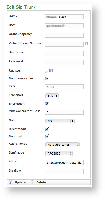figure 1. "Edit Sip Trunk" form
In figure 1. "Edit Sip Trunk" form you can see an example configuration for creating a SECURE Inbound SIP Trunk. The mandatory values are:
- NAME: a meaningful name for this trunk
- HOST: IP address/hostname of the SIP server provided by ITSP
- PORT: this is 5061 by RFC
- TRANSPORT: TLS
- ENCRYPTION: check it enabled
- DIRECTMEDIA: check it enabled
- SENDRPID: check it enabled
The default values for Port, Allow and Disallow are usually work well, however feel free to change them to suite your needs better.
Optional fields are:
- CONCURRENT CALLS: you can leave the default, which is often a practice value for the day-by-day service and change it later if you notice call drops on this Trunk.
NAT: check this box only if you are not using directly the public IP address on the trunk interface.
No interface binding for the trunk! The trunk would use the default gateway you configured in the PSAM 2.1 Network Configuration
- AUDIO TONES: ON EARLY MEDIA works fine with the Cisco Unity Call Manager. Avaya instead can deal with both N EARLY MEDIA and ON ANSWERED CALL.
- DTMFMODE: choose your values considering the PBX on the other end of the Trunk. Usually we suggest to choose the value RFC2833
- ALLOW: the values of this fields highly depends from what the other end is capable of. Our suggestion is to leave the default: g729,amr,gsm,ulaw,alaw
- DISALLOW: the values of this fields highly depends from what the other end is capable of. Our suggestion is to leave this field empty.
